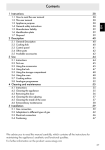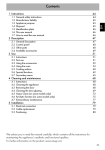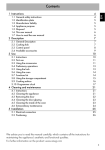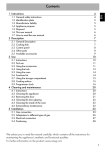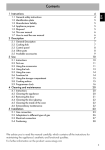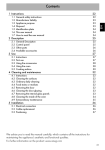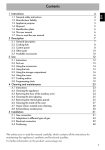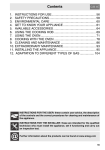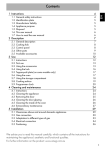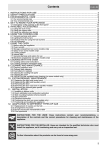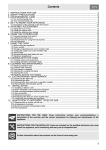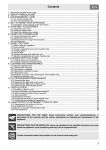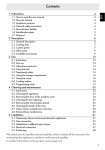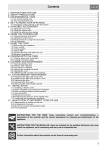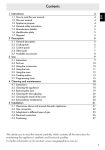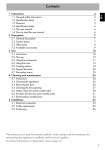Download Contents
Transcript
Contents 1.1 1.2 1.3 1.4 1.5 1.6 1.7 General safety instructions Identification plate Manufacturer liability Appliance purpose Disposal This user manual How to read the user manual 2 Description 2.1 2.2 2.3 2.4 General description Cooking hob Control panel Other parts 3 Use 3.1 3.2 3.3 3.4 3.5 3.6 3.7 3.8 Instructions Cleaning the appliance Removing the door Cleaning the door glazing Cleaning the inside of the oven Extraordinary maintenance 5 Installation 5.1 5.2 5.3 5.4 7 8 8 8 8 9 9 10 10 10 11 11 13 Instructions First use Using the accessories Using the storage compartment Using the hob Using the oven Cooking advice Programmer clock 4 Cleaning and maintenance 4.1 4.2 4.3 4.4 4.5 4.6 7 EN 1 Instructions Gas connection Adaptation to different types of gas Electrical connection Positioning 13 14 14 16 16 17 18 19 23 23 23 24 24 25 26 27 27 29 31 32 We advise you to read this manual carefully, which contains all the instructions for maintaining the appliance's aesthetic and functional qualities. For further information on the product: www.smeg.com 3 Instructions READ BEFORE USE IMPORTANT INSTRUCTIONS GAS/ELECTRIC COOKERS Gas/Gas Cookers: All Cookers: • To avoid over heating when the oven or grill is being used the glass cover must always be up. • The glass cover may not be cooked on, or closed when the burners are in use and while they are still warm. • The gas oven and gas grill can not be used simultaneously. • Never place aluminum or foil at the bottom of the oven and do not place oven trays as this may damage the enamel coating by over heating. • The manufacturer declines all responsibility for improper use. • Never attempt to repair or install the appliance yourself as the guarantee will fall away. • Installation must be done by a qualified gas installer and qualified electrician. • Retain your proof of purchase for guarantee. 4 Additional installation information for SMEG gas hobs and stoves supplied to South Africa All Smeg appliances comply with SANS 1539 and have been issued with Permit numbers by the Liquefied Petroleum Gas Safety Association of Southern Africa. Gas Type: LPG (Note: This appliance may have been supplied ex factory with setting and jets for Natural Gas. Your installer must make the necessary changes and adjustments before handing over the installed appliances for use). Operating Pressure: 2.8 kPa Note that this appliance may only be used with a LPG regulator of 2.8 kPa outlet pressure and that complies with requirements of SABS 1237. • This appliance may only be installed by a qualified Gas Fitter that is registered with the LPGSASA. All registered Gas fitters are issued with an identity card and this also carries their registration number. Make a note of this. The Gas Fitter should also provide you with a written certificate after completing the work. Before the installer hands over the installed appliance ensure that you are advised the location of the isolation or shut off valve in the gas supply line to the appliance and how to operate it. • Do not modify the appliance in any way as this may make it unsafe. • Note carefully that ventilation requirements indicated in the specific model instruction booklet. This information is vital for the safety of the occupants of the area in which the appliance is installed and used. • Never check for gas leaks with a naked flame. Always use a soapy water solution applied with a brush to the areas where you suspect there may be a gas leak. Do not use the appliance if you suspect a gas leak. • There are no preset service intervals for this appliance. Refer to the section on maintenance and cleaning in the instruction booklet for details on how to care for your SMEG appliance. • After removing burner caps or burner heads to clean them or the hob surface around the burners, always take care that the burner heads are properly located in position and that the igniter post and flame failure thermocouple are not damaged in any way. It is important that these devices fit correctly into the location holes provided in the burner heads. They will not function correctly if not properly located. The burner caps locate by means of the ridge on the underside. Note that burners will not work efficiently if the burner caps are not properly located. There are drawings of a typical burner assembly in your instruction booklet. Supplied in South Africa by: S.B.S. Household Appliances, 89 Impala Road, Kelvin view, Eastgate Ext.8 (off Marlboro) tel: (011) 656 0025 National Call Center: 0860 102 984 email: [email protected] 5 EN Instructions Instructions FOR YOUR SAFETY IF YOU SMELL GAS: • Turn off gas supply at bottle • Extinguish all naked flames; • Do not operate any electrical appliances • Ventilate the area • Check for leaks as detailed in this manual If odour persists, contact your dealer or gas supplier immediately Do not temper with the appliance. BURN-BACK (FIRE IN BURNER TUBE OR CHAMBER) In the event of a burn-back, where the flame burns back to the jet, immediately turn off the gas supply at the control valve on the panel. After ensuring the flame is extinguished, wait for I minute and re-light the appliance in the normal manner. Should the appliance again burn back, close the control valve and call a service technician. Do not use the appliance again until the service technician has declared that it is safe to do so. GAS-PRESSURE REGULATOR This appliance requires an operating pressure of 2,8 kPa at the appliance. A suitable LPG regulator that complies with the requirements of SANS 1237 must be installed. 6 IMPORTANT INFORMATION FOR THE USER This appliance may only be installed by a registered LP Gas installer. All registered installers are issued with a card carrying their registration number. Ask to be shown the card before allowing the installation work to commence and make a note of the Installer QCC number. Upon completion of the installation, the installer is required to explain the operational details of the appliance together with the safety instructions. You will be asked to sign acceptance of the installation and be provided with a completion certificate. You should only sign for acceptance of the installation when the installation is completed to your satisfaction. Note that your invoice is required in the event that you wish make a guarantee claim. IMPORTANT INFORMATION FOR THE INSTALLER. This appliance may only be installed by a LP gas installer registered with the Liquefied Petroleum Gas Association of Southern Africa. The appliance must be installed in accordance with the requirements of SANS 10087-1 and any fire department regulations and/or local bylaws applicable to the area. If in doubt check with the relevant authority before undertaking the installation. Upon completion of the installation you are required to fully explain and demonstrate to the user the operational details and safety practices applicable to the appliance and the installation. 1 Instructions 1.1 General safety instructions Risk of personal injury • During use the appliance and its accessible parts become very hot. • Never touch the heating elements during use. • Keep children under eight years of age at a safe distance if they are not constantly supervised. • Children must never play with the appliance. • This appliance may be used by children aged at least 8 and by people of reduced physical and mental capacity, or lacking in experience in the use of electrical appliances, as long they are supervised or instructed by adults who are responsible for their safety. • Never rest metallic objects such as knives, forks, spoons and lids on the appliance during use. • Switch the appliance off immediately after use. • Never try to put out a fire or flames with water: turn off the appliance and smother the flames with a fire blanket or other appropriate cover. • The appliance must never be cleaned by unsupervised children. • Have qualified personnel carry out installation and assistance interventions according to the standards in force. • Do not modify this appliance. • Do not insert pointed metal objects (cutlery or utensils) into the slots in the appliance. • Do not try to repair the appliance yourself or without the intervention of a qualified technician. • If the power supply cable is damaged, contact technical support immediately and they will replace it. • Do not open the storage compartment when the oven is on and still hot. • The items inside the storage compartment could be very hot after using the oven. Risk of damaging the appliance • Do not use abrasive or corrosive detergents on glass parts (e.g. powder products, stain removers and metallic sponges). • Racks and trays have to be inserted into the side guides until they come to a complete stop. The mechanical safety locks that prevent the rack from being taken out accidentally have to face downwards and towards the oven back. 7 EN Instructions Instructions • Use wooden or plastic utensils. • Do not seat on the appliance. • Do not use steam jets for cleaning the appliance. • Do not obstruct ventilation openings and heat dispersal slots. • Never leave the appliance unattended during cooking operations where fats or oils could be released. • Never leave objects on the cooking surface. • Do not use the appliance to heat rooms for any reason. • Remove any food residues or large spills from previous cooking operations from the inside of the oven. 1.3 Manufacturer liability For this appliance • Before replacing the bulb, switch off the power supply to the appliance. • Do not rest any weight or sit on the open door of the appliance. • Take care that no objects are stuck in the doors. This appliance must be disposed of separately from other waste (Directives 2002/95/EC, 2002/ 96/EC, 2003/108/EC). The appliance does not contain substances in quantities sufficient to be considered hazardous to health and the environment, in accordance with current European directives. To dispose of the appliance: • Cut the power supply cable and remove it along with the plug. 1.2 Identification plate • The identification plate bears the technical data, serial number and brand name of the appliance. Do not remove the identification plate for any reason. The manufacturer declines all liability for damage to persons or property caused by: • use of the appliance other than the one envisaged; • non-observance of the user manual provisions; • tampering with any part of the appliance; • use of non-original spare parts. 1.4 Appliance purpose • This appliance is intended for cooking food in the home environment. Every other use is considered improper. • The appliance is not designed to operate with external timers or with remote-control systems. 1.5 Disposal Power voltage Danger of electrocution • Disconnect the main power supply. • Disconnect the power cable from the electrical system. 8 • Consign the appliance to the appropriate selective collection centres for electrical and electronic equipment waste, or deliver it back to the retailer when purchasing an equivalent product, on a one for one basis. Our appliances are packed in nonpolluting and recyclable materials. • Consign the packing materials to the appropriate selective collection centres. Plastic packaging Danger of suffocation • Do not leave the packaging or any part of it unattended. • Do not let children play with the packaging plastic bags. 1.6 This user manual This user manual is an integral part of the appliance and must therefore be kept in its entirety and within the user's reach for the whole working life of the appliance. Read this user manual carefully before using the appliance. 1.7 How to read the user manual This user manual uses the following reading conventions: Instructions General information on this user manual, on safety and final disposal. Description Description of the appliance and its accessories. Use Information on the use of the appliance and its accessories, cooking advice. Cleaning and maintenance Information for proper cleaning and maintenance of the appliance. Installation Information for the qualified technician: installation, operation and inspection. Safety instructions Information Advice 1. Use instruction sequence. • Single use instruction. 9 EN Instructions Description 2 Description 2.1 General description 1 Cooking hob 2 Control panel 3 Oven light 4 Seal 5 Door 6 Fan 7 Storage compartment Rack/tray support frame shelf 2.2 Cooking hob AUX = Auxiliary SR = Semi-rapid 10 R = Rapid UR = Ultra rapid Description Programmer clock (1) Useful for displaying the current time, setting programmed cooking operations and programming the minute minder timer. Temperature knob (2) This knob allows you to select the cooking temperature. Turn the knob clockwise to the required value, between the minimum and maximum settings. Indicator light (3) The indicator light comes on to indicate that the oven is heating up. It turns off as soon as it reaches the set temperature. It flashes regularly to indicate that the temperature set inside the oven is kept constant. Function knob (4) The oven's various functions are suitable for different cooking modes. After selecting the required function, set the cooking temperature using the temperature knob. Hob burner knobs (5) Useful for lighting and adjust the hob burners. Press and turn the knobs anticlockwise to the value to light the relative burners. Turn the knobs to the zone between the maximum and minimum setting to adjust the flame. Return the knobs to the position to turn off the burners. EN 2.3 Control panel 2.4 Other parts Shelves The appliance features shelves for positioning trays and racks at different heights. The insertion heights are indicated from the bottom upwards (see 2.1 General description). Cooling fan The fan cools the ovens and comes into operation during cooking. The fan causes a steady outflow of air from above the door and which may continue for a brief period of time even after the appliance has been turned off. Internal light The internal light of the ovens comes on when any function is selected. Available accessories Some models are not provided with all accessories. Rotisserie support To be used to support the rotisserie rod. 11 Description Rotisserie rod Useful for collecting fat from foods placed on the rack above. Tray rack Useful for cooking chicken and all foods which require uniform cooking over their entire surface. Rotisserie handle To be placed over the top of the oven tray; for cooking foods which may drip. Reduction pan stand Useful to extract the rotisserie rod out of the oven cavity. Rack Useful when using small cookware. Wok reduction pan stand Useful when using a wok. Useful for supporting containers with food during cooking. Oven tray The accessories intended to come into contact with food are made of materials that comply with the provisions of current legislation. Supplied and optional accessories can be requested to Authorised Assistance Centres. Use only original accessories supplied by the manufacturer. 12 Use 3.1 Instructions High temperature inside the oven during use Danger of burns • Keep the oven door closed during cooking. • Protect your hands using heat resistant gloves when moving food inside the oven. • Do not touch the heating elements inside the oven. • Do not pour water directly on very hot trays. • Young children should be supervised to ensure that they do not play with the appliance. • If you need to move food or at the end of cooking, open the door 5 cm for a few seconds, let the steam come out, then open it fully. Improper use Danger of burns • Make sure that the flame-spreader crowns are correctly positioned in their housings with their respective burner caps. • Oils and fat could catch fire if overheated. Be very careful. • During use the appliance becomes hot. Care should be taken to avoid touching heating elements inside the oven. • Accessible parts will become hot when in use. To avoid burns young children should be kept away. Improper use Risk of damage to surfaces EN 3 Use • Do not cover the bottom of the oven with aluminium or tin foil sheets. • If you wish to use greaseproof paper, place it so that it will not interfere with the hot air circulation inside the oven. • Do not place pans or trays directly on the bottom of the cooking compartment. • Do not use the open door to rest pans or trays on the internal glass pane. • Make sure that the flame-spreader crowns are correctly positioned in their housings with their respective burner caps. • The cooking vessels or griddle plates should be placed inside the perimeter of the hob. Not suitable for use with aftermarket lids or covers. • All pans must have smooth, flat bottoms. • If any liquid does boil over or spill, remove the excess from the hob. • Do not place anything, e.g. flame tamer or griddle plate between pan and pan support. • Do not remove the pan support and enclose the burner with a wok stand, only use the wok support supplied. • Do not use large pots or heavy weights which can bend the pan support or deflect flame onto the hotplate. • Locate pan centrally over the burner so that it is stable and does not overhang the appliance. 13 Use High temperature Danger of fire or explosion • Do not spray aerosols in the vicinity of this appliance while it is in operation. • Do not use or store flammable materials in the appliance storage drawer or near this appliance. • Do not use plastic kitchenware or containers when cooking food. • Do not put sealed tins or containers in the oven. • Do not leave the oven unattended during cooking operations where fats or oils could be released. • Remove from the oven compartment all trays and racks not used during cooking. • Where this appliance is installed in marine craft or in caravans, it shall not be used as a space heater. • Do not modify this appliance. 3.2 First use 1. Remove any protective film from the outside or inside of the appliance, including accessories. 2. Remove any labels (apart from the technical data plate) from the accessories and from the cooking compartments. 3. Remove all the accessories from the appliance and clean them (see 4 Cleaning and maintenance). 4. Heat the empty ovens at the maximum temperature to burn off any residues left by the manufacturing process. 14 3.3 Using the accessories Racks and trays Racks and trays have to be inserted into the side guides until they come to a complete stop. • The mechanical safety locks that prevent the rack from being taken out accidentally have to face downwards and towards the oven back. Gently insert racks and trays into the oven until they come to a stop. Clean the trays before using them for the first time to remove any residues left by the manufacturing process. Tray rack The tray has to be inserted into the rack. In this way fat can be collected separately from the food which is being cooked. Reduction pan stands The reduction pan stands have to be placed on the hob grids. Make sure they are properly placed. Rotisserie rod Prepare the rotisserie rod with the food using the clip forks provided. Once you have prepared the rotisserie rod, place it on the the rotisserie support. Insert the rod into the hole so that it connects with the rotisserie motor. Make sure that the contoured part is placed correctly on the guide frame and remove the handle. To activate the rotisserie, turn the function knob on the position. When cooking is over, use the rotisserie handle provided to extract the rod from the hole and remove the frame to bring the rotisserie rod out of the oven cavity. Screw on the handle provided so that you can handle the rod with the food on it readily. These operations must be carried out with the oven switched off and cold. 15 EN Use Use 3.4 Using the storage compartment The storage compartment is at the bottom of the cooker. To open it, pull the handle towards you. It can be used to store cookware or metallic objects necessary when using the appliance. Correct position for flame-spreader crowns and burner caps Before lighting the hob burners, make sure that the flame-spreader crowns are correctly positioned in their housings with their respective burner caps. Make sure that the holes 1 in the flame-spreader crowns are aligned with the igniters 3 and thermocouples 2. 3.5 Using the hob All the appliance's control and monitoring devices are located together on the front panel. The burner controlled by each knob is shown next to the knob. The appliance is equipped with an electronic ignition device. Simply press the knob and turn it anticlockwise to the maximum flame symbol, until the burner lights. If the burner does not light in the first 15 seconds, turn the knob to and wait 60 seconds before trying again. After lighting, keep the knob pressed down for a few seconds to allow the thermocouple to heat up. The burner may go out when the knob is released: in this case, the thermocouple has not heated up sufficiently. Wait a few moments and repeat the operation. Keep the knob pressed in longer. In case of an accidental switching off, a safety device will be tripped, cutting off the gas supply, even if the gas tap is open. Return the knob to and wait at least 60 seconds before lighting it again. 16 Practical tips for using the hob For better burner efficiency and to minimise gas consumption, use pans with lids and of suitable size for the burner, so that flames do not reach up the sides of the pan. Once the contents come to the boil, turn down the flame far enough to ensure that the liquid does not boil over. Pan diameters: • Auxiliary: 12 - 14 cm. • Semi-rapid: 16 - 24 cm. • Rapid: 18 - 26 cm. • Ultra-rapid: 18 - 26 cm 3.6 Using the oven Switching on the oven To switch the oven on: 1. Select the cooking function using the function knob. 2. Select the temperature using the temperature knob. Functions list Static As the heat comes from above and below at the same time, this system is particularly suitable for certain types of food. Traditional cooking, also known as static cooking, is suitable for cooking just one dish at a time. Perfect for all types of roasts, bread and cakes and in any case particularly suitable for fatty meats such as goose and duck. Bottom The heat coming just from the bottom allows you to complete the cooking of foods that require a higher bottom temperature, without affecting their browning. Perfect for cakes, pies, tarts and pizzas. Grill The heat coming from the grill element gives perfect grilling results above all for thin and medium thickness meat and in combination with the rotisserie (where present) gives the food an even browning at the end of cooking. Perfect for sausages, ribs and bacon. This function enables large quantities of food, particularly meat, to be grilled evenly. Fan-assisted grill The air produced by the fan softens the strong heatwave generated by the grill, grilling perfectly even very thick foods. Perfect for large cuts of meat (e.g. shin of pork). Fan-assisted static The operation of the fan, combined with traditional cooking, ensures uniform cooking even with complex recipes. Perfect for biscuits and cakes, even when simultaneously cooked on several levels. (For multiple-level cooking, we recommend using the 2nd and 4th shelves.) Small grill + rotisserie The rotisserie works in combination with the central grill heating element and allows food to be perfectly browned. 17 EN Use Use Fan-assisted circular The combination of the fan and the circular element (incorporated in the rear of the oven) allows you to cook different foods on several levels, as long as they need the same temperatures and same type of cooking. Hot air circulation ensures instant and uniform distribution of heat. It will be possible, for instance, to cook fish, vegetables and biscuits simultaneously (on different levels) without mixing odours and flavours. Defrosting Rapid defrosting is helped by switching on the fan provided and the top heating element that ensure uniform distribution of low temperature air inside the oven. 3.7 Cooking advice General advice • Use a fan-assisted function to achieve uniform cooking at several levels. • It is not possible to shorten cooking times by increasing the temperature (the food could be overcooked on the outside and undercooked on the inside). • Using more ovens at the same time might affect the final cooking results. Advice for cooking meat • Cooking times vary according to the thickness and quality of the food and to consumer taste. • Use a meat thermometer when roasting meat, or simply press on the roast with a spoon. If it is hard, it is ready; if not, it needs another few minutes cooking. 18 Advice for cooking with the Grill and the Fan-assisted grill • Meat can be grilled even when it is put into the cold oven or into the preheated oven if you wish to change the effect of the cooking. • With the Fan-assisted grill function, we recommend that you preheat the oven before grilling. • We recommend placing the food at the centre of the rack. • With the Grill function, we recommend that you turn the temperature knob to the maximum value near the or symbol to optimise cooking. • Foods should be seasoned before cooking. Foods should also be coated with oil or melted butter before cooking. • Use the oven tray on the first bottom shelf to collect fluids produced by grilling. • Grilling processes should never last more than 60 minutes. Advice for cooking desserts and biscuits • Use preferably dark metal moulds: they help to absorb the heat better. • Temperature and cooking time depend on the quality and consistency of the dough. • To check whether the dessert is cooked right through: at the end of the cooking time, put a toothpick into the highest point of the dessert. If the dough does not stick to the toothpick, the dessert is cooked. • If the dessert collapses when it comes out of the oven, on the next occasion reduce the set temperature by about 10°C, selecting a longer cooking time if necessary. Use 3.8 Programmer clock EN • While cooking desserts or vegetables, excessive condensation may form on the glass. In order to avoid this, open the door very carefully a couple of times while cooking. Advice for defrosting and proving • Place frozen foods without their packaging in a lidless container on the first shelf of the oven. • Avoid overlapping the food. • To defrost meat, use the rack placed on the second level and a tray on the first level. In this way, the liquid from the defrosting food drains away from the food. • The most delicate parts can be covered with aluminium foil. • For successful proving, a container of water should be placed in the bottom of the oven. To save energy • Stop cooking a few minutes before the time normally used. Cooking will continue for the remaining minutes with the heat which has accumulated inside the oven. • Reduce any opening of the door to a minimum to avoid heat dispersal. • Keep the inside of the appliance clean at all times. 1 Minute minder timer key 2 Cooking duration key 3 End of cooking key 4 Value decrease key 5 Value increase key The programmer clock controls exclusively the right multifunction oven and has not any control on the other ovens. 19 Use Setting the time On the first use, or after a power failure, the digits will be flashing on the appliance's display. 1. Press the and keys at the same time. The dot between the hours and the minutes flashes. 2. The time can be set using or . Keep the key pressed in to increase or decrease rapidly. 3. Press the key or wait 5 seconds. The dot between the hours and the minutes stops flashing. 3. Wait approx. 5 seconds without pressing any key in order for the function to activate. The current time and the symbols and will appear on the display. 4. At the end of cooking the heating elements will be deactivated. On the display, symbol turns off, symbol flashes and the buzzer sounds. 5. To turn off the buzzer just press any key of the programmer clock. 6. Press keys and at the same time to reset the programmer clock. 4. The symbol on the display indicates that the appliance is ready to start cooking. It is not possible to set a cooking time of more than 10 hours. Timed cooking After the setting, to display the cooking time left press the key. Timed cooking is the function which allows a cooking operation to be started and then ended after a specific length of time set by the user. 1. After selecting a cooking function and temperature, press key . The display will shows the digits and the symbol displayed between the hours and the minutes. 2. Use the minutes. or key to set the required To reset the set program, press keys and at the same time and switch off the oven manually. Programmed cooking Programmed cooking is the function which allows a cooking operation to be started at a set time and then ended after a specific length of time set by the user. 1. Set the cooking time as described in the previous point “Timed cooking”. 2. Press . The sum of the current time plus the pre-set cooking duration will appear on the display. 20 3. Use the or key to set the required minutes. 4. Wait approx. 5 seconds without pressing any key in order for the function to activate. The current time and the symbols and will appear on the display. 5. At the end of cooking the heating elements will be deactivated. On the display, symbol turns off, symbol flashes and the buzzer sounds. 6. To turn off the buzzer just press any key of the programmer clock. 7. Press keys and at the same time to reset the programmer clock. After the setting, to display the cooking time left press the key. To display the end of cooking time, press the key. Minute minder timer The minute minder timer does not stop the cooking operation but rather informs the user when the set time has run out. 3. Wait approx. 5 seconds without pressing any key to finish setting the minute minder. The current time and the symbols and appear on the display. It is not possible to set a cooking time of more than 24 hours. After the minute minder timer has been programmed, the display will go back to showing the current time; to display the remaining time, press . Adjusting the buzzer volume The buzzer volume can be set to 3 different levels. When the buzzer is in operation, press to change the setting. Deleting the set data Press keys and at the same time to reset the programs set. Then switch off the oven manually if cooking is in progress. The minute minder timer can be activated at any time. 1. Press . The display shows the digits and the indicator light flashing between the hours and the minutes. 2. Use the minutes. or key to set the required 21 EN Use Use Cooking information table Temperature Static Static Runner position from the bottom 1 1 220 - 230 220 - 230 45 - 50 45 - 50 2 2 1.5 1 1.5 3 2-3 1.2 Turbo Turbo Fan with grill Turbo Circulaire Turbo Turbo Turbo 2 2 4 2 2 2 2 2 180 - 190 180 - 190 280 200 180 - 190 180 - 190 180 - 190 180 - 190 90 - 100 70 - 80 15 40 - 45 70 - 80 110 - 120 170 - 180 65 - 70 Pork chops Spare ribs Bacon Pork fillet Beef fillet 1.5 1.5 0.7 1.5 1 Fan with grill Fan with grill Grill Fan with grill Grill 4 4 5 4 5 280 280 250 - 280 250 - 280 250 - 280 Salmon trout Monkfish Turbot 1.2 1.5 1.5 Turbo Turbo Turbo 2 2 2 150 - 160 160 160 35 - 40 60 - 65 45 - 50 1 1 1 Turbo Circulaire Turbo 2 2 2 280 190 - 200 180 - 190 8-9 25 - 30 20 - 25 1 1 1 1 1.2 1.2 1 1 0.6 Circulaire Circulaire Circulaire Turbo Circulaire Turbo Circulaire Turbo Circulaire 2 2 2 2 2 2 2 2 2 160 160 160 - 170 160 160 180 150 - 160 160 160 55 - 60 35 - 40 55 - 60 20 - 25 55 - 60 80 - 90 55 - 60 55 - 60 30 - 35 Weight (Kg) Function Lasagne Pasta bake 3-4 3-4 Roast veal Pork Sausages Roast beef Roast rabbit Turkey breast Roast pork neck Roast chicken Food (°C) Time (minutes) 1st surface 2nd surface Pizza Bread Focaccia Bundt cake Jam tart Ricotta cake Jam tarts Paradise cake Profiteroles Sponge cake Rice pudding Brioches 15 10 7 10 10 5 10 8 5 7 The times indicated in the table do not include preheating times and are provided as a guide only. 22 4 Cleaning and maintenance 4.1 Instructions Improper use Risk of damage to surfaces • Do not use steam jets for cleaning the appliance. • Do not use cleaning products containing chlorine, ammonia or bleach on steel parts or parts with metallic finishes on the surface (e.g. anodizing, nickel- or chromium-plating). • Do not use abrasive or corrosive detergents on glass parts (e.g. powder products, stain removers and metallic sponges). • Do not use rough or abrasive materials or sharp metal scrapers. • Do not wash the removable components such as the hob pan stands, flame-spreader crowns and burner caps in a dishwasher. 4.2 Cleaning the appliance To keep the surfaces in good condition, they should be cleaned regularly after use. Let them cool first. Ordinary daily cleaning Always use only specific products that do not contain abrasives or chlorine-based acids. Pour the product onto a damp cloth and wipe the surface, rinse thoroughly and dry with a soft cloth or a microfibre cloth. Food stains or residues Do not use metallic sponges or sharp scrapers as they will damage the surfaces. Use ordinary non-abrasive products with the aid of wooden or plastic utensils if necessary. Rinse thoroughly and dry with a soft cloth or a microfibre cloth. Do not allow residues of sugary foods (such as jam) to set inside the oven. If left to set for too long, they might damage the enamel lining of the oven. Cooking hob pan stands Remove the pan stands and clean them with lukewarm water and non-abrasive detergent. Make sure to remove any encrustations. Dry them thoroughly and return them to the hob. Continuous contact between the pan stands and the flame can cause modifications to the enamel over time in those parts exposed to heat. This is a completely natural phenomenon which has no effect on the operation of this component. Flame-spreader crowns and burner caps For easier cleaning, the flame-spreader crowns and the burner caps can be removed. Wash them in hot water and nonabrasive detergent. Carefully remove any encrustation, then wait until they are perfectly dry. Refit the flame-spreader crowns making sure that they are correctly positioned in their housings with their respective burner caps. 23 EN Cleaning and maintenance Cleaning and maintenance Igniters and thermocouples For correct operation the igniters and thermocouples must always be perfectly clean. Check them frequently and clean them with a damp cloth if necessary. Remove any dry residues with a wooden toothpick or a needle. 4.3 Removing the door 2. Grasp the door on both sides with both hands, lift it forming an angle of around 30° and remove it. 3. To reassemble the door, put the hinges in the relevant slots in the oven, making sure that grooved sections A are resting completely in the slots. Lower the door and once it is in place remove the pins from the holes in the hinges. For easier cleaning, the door can be removed and placed on a canvas. To remove the door proceed as follows: 1. Open the door completely and insert two pins into the holes on the hinges indicated in the figure. 4.4 Cleaning the door glazing The glass in the door should always be kept thoroughly clean. Use absorbent kitchen roll. In case of stubborn dirt, wash with a damp sponge and an ordinary detergent. We recommend the use of cleaning products distributed by the manufacturer. 24 4.5 Cleaning the inside of the oven Removing racks/trays support frames For the best oven upkeep, clean it regularly after having allowed it to cool. Take out all removable parts. Removing the rack/tray support frames enables the sides to be cleaned more easily. Removing the rack/tray support frames: 1. Unscrew the two fastening pins of the frame. Clean the oven racks with warm water and non-abrasive detergent. Carefully rinse and dry the damp parts. The oven should be operated at the maximum temperature for about 15-20 minutes after the use of specific products, to burn off the residues left inside the oven. EN Cleaning and maintenance 2. Pull out the frame toward the interior. If self-cleaning panels are fitted they have to be removed together wit the frame. For easier cleaning, remove the door. 3. When cleaning is complete, repeat the above procedures to put the guide frames back in. 25 Cleaning and maintenance 4.6 Extraordinary maintenance Live parts Danger of electrocution • Ensure the appliance is switched off before replacing the lamp to avoid the possibility of electric shock. Removing the seal To permit thorough cleaning of the oven, the door seal can be removed. There are hooks on all four sides to attach it to the edge of the oven. Pull the edges of the seal outwards to detach the hooks. Replacing the internal light bulb Remove the bulb protector A by turning it anticlockwise and replace bulb B with a similar one. Re-fit bulb protector A. To keep the seals clean, use a non-abrasive sponge and lukewarm water. Seals should be soft and elastic. 26 5 Installation 5.1 Gas connection Gas leak Danger of explosion • After carrying out any operation, check that the tightening torque of gas connections is between 10 Nm and 15 Nm. • If required, use a pressure regulator that complies with current regulations. • At the end of the installation, check for any leaks with a soapy solution, never with a flame. • Installation with flexible hose must be carried out so that the length of the piping does not exceed 2 metres when fully extended as regards flexible steel hoses and 1.5 metres in case of rubber hoses. • The hoses should not come into contact with moving parts and should not be crushed in any way. General information Connection to the gas supply network can be made using a continuous wall flexible steel hose in compliance with the guidelines established by the standards in force. The gas inlet connection is threaded ½” external gas (ISO 228-1). • the hose is not under traction or tension and has no kinks or twists; • the hose is not in contact with sharp objects or sharp corners; • if the hose is not perfectly airtight and leaks gas, do not try to repair it; replace it with a new hose. • verify that the hose is not past its expiry date (serigraphed on the hose itself). Make the connection to the gas mains using a rubber hose whose specifications comply with current standards (verify that the reference standard is stamped on the hose). Carefully screw the hose connector 3 to the appliance’s gas connector 1 (½” thread ISO 228-1), placing the seal 2 between them. The hose connector 4 can also be screwed to the hose connector 3, depending on the diameter of the gas hose used. After having tightened the hose connector(s), push the gas hose 6 onto the hose connector and secure it with the clamp 5 that is compliant with the standard in force. Connection with a rubber hose Verify that all following conditions are met: • the hose is fixed to the hose connection with safety clamps; • no part of the hose is in contact with hot walls (max. 50 °C); 27 EN Installation Installation Connection using a rubber hose complying with current standards is only permitted if the hose can be inspected along its entire length. the thread of connector 3, then tighten the flexible steel hose 4 to the connector 3. The inside diameter of the hose must be 8 mm for LPG and 13 mm for Natural gas and City gas. Connection with a flexible steel hose Make the connection to the gas mains using a continuous wall flexible steel hose whose specifications comply with the current regulations. Carefully screw the connector 3 to the gas connector 1 of the appliance, placing the seal 2 between them. Connection with a flexible steel hose with conical fitting Make the connection to the gas mains using a continuous wall flexible steel hose whose specifications comply with current regulations. Carefully screw the hose connector 3 to the appliance’s gas connector 1 (½” thread ISO 228-1), placing the supplied seal 2 between them. Apply insulating material to 28 Connection to LPG Use a pressure regulator and make the connection on the gas cylinder following the guidelines set out in the regulations in force. The supply pressure must comply with the values indicated in the table in “Burner and nozzle characteristics tables”. Room ventilation The appliance should be installed in rooms that have a permanent air supply in accordance with the standards in force. The room where the appliance is installed must have enough air flow needed for the regular combustion of gas and the necessary air change in the room itself. The air vents, protected by grilles, must be the right size to comply with current regulations and positioned so that no part of them is obstructed, not even partially. Installation Extraction of the combustion products The combustion products may be extracted by means of hoods connected to a natural draught chimney whose efficiency is certain or via forced extraction. An efficient extraction system requires precision planning by a specialist qualified in this area and must comply with the positions and distances indicated by the applicable standards. When the job is complete, the installer must issue a certificate of conformity. Air EN The room must be kept adequately ventilated in order to eliminate the heat and humidity produced by cooking: in particular, after prolonged use, you are recommended to open a window or to increase the speed of any fans. Combustion products Extractor fan 5.2 Adaptation to different types of gas In case of operation with other types of gas, the burner nozzles must be changed and the minimum flame adjusted on the gas taps. Replacing the hob nozzles 1. Remove the pan stands, burner caps and flame-spreader crowns to access the burner casings. 2. Replace the nozzles using a 7 mm spanner according to the gas to be used (see Burner and nozzle characteristics tables). 3. Replace the burners in the correct position. 1 Extraction using a hood 2 Extraction without a hood A Single natural draught chimney B Single chimney with extractor fan C Directly outdoors with wall- or windowmounted extractor fan D Directly outdoors through wall 29 Installation Lubricating the gas taps Over time the gas taps may become difficult to turn and get blocked. Clean them internally and replace the grease. Lubrication of the gas taps should be performed by a specialised technician. Adjusting the hob burner minimum setting for natural gas Light the burner and turn it to the minimum position. Extract the gas tap knob and turn the adjustment screw next to the tap rod (depending on the model) until the correct minimum flame is achieved. Refit the knob and verify that the burner flame is stable. Turn the knob rapidly from the maximum to the minimum setting: the flame should not go out. Repeat the operation on all gas taps. Adjusting the hob burner minimum setting for LPG Tighten the screw located at the side of the tap rod clockwise all the way. Following adjustment to a gas other than the one originally set in the factory, replace the gas setting label fixed to the appliance with the one corresponding to the new gas. The label is inserted inside the nozzle pack (where present). Burner and nozzle characteristics tables NATURAL gas – G20 20 mbar AUX SR R UR Rated heating capacity (kW) Nozzle diameter (1/100 mm) Pre-chamber (printed on nozzle) Reduced capacity (W) 1.05 72 (X) 400 1.8 97 (Z) 500 3.0 115 (Y) 800 3.9 135 (K) 1600 Liquid gas – G30/G31 30-37 mbar AUX SR R UR Rated heating capacity (kW) Nozzle diameter (1/100 mm) Reduced capacity (W) Rated capacity G30 (g/h) Rated capacity G31 (g/h) 1.05 50 400 76 75 1.8 65 500 127 125 3.0 85 800 218 214 3.9 100 1600 284 279 30 Installation • 380-415 V 2N~ EN 5.3 Electrical connection Power voltage Danger of electrocution • Have the electrical connection performed by authorised technical personnel. • Use personal protective equipment. • The appliance must be connected to earth in compliance with electrical system safety standards. • Disconnect the main power supply. • Do not pull the cable to remove the plug. • Use cables withstanding a temperature of at least 90°C. • The tightening torque of the screws of the terminal supply wires must be 1.5 - 2 Nm. General information Check the grid characteristics against the data indicated on the plate. The identification plate bearing the technical data, serial number and brand name is visibly positioned on the appliance. Do not remove this plate for any reason. Perform the ground connection using a wire that is 20 mm longer than the other wires. The appliance can work in the following modes: • 220-240 V 1N~ Use a 4 x 1.5 mm² four-core cable. • 380-415 V 3N~ Use a 5 x 1.5 mm² five-core cable. The values indicated above refer to the cross-section of the internal conductor. Fixed connection Fit the power line with an omnipolar circuit breaker in compliance with installation regulations. The circuit breaker should be located near the appliance and in an easily reachable position. Connection with plug and socket Make sure that the plug and socket are of the same type. Avoid using adapters and shunts as these could cause overheating and a risk of burns. Use a 3 x 2.5 mm² three-core cable. 31 Installation 5.4 Positioning Heavy appliance Danger of crush injuries • Place the appliance into the piece of furniture with the aid of a second person. Pressure on the open door Risk of damages to the appliance • Never use the oven door to lever the appliance into place when fitting. • Avoid exerting too much pressure on the oven door when open. Heat production during appliance operation Risk of fire • Veneers, adhesives or plastic coatings on adjacent furniture should be temperature-resistant (no less than 90°C). If a hood is installed above the hob, refer to the hood instruction manual to ensure the correct clearance is left. Depending on the type of installation, this appliance belongs to classes: General information This appliance may be installed next to walls, one of which must be higher than the worktop, at a minimum distance of 50 mm from the side of the appliance, as shown in figures A and C relative to the installation classes. Any wall units positioned above the worktop must be at a minimum distance of at least 750 mm. A - Class 1 (Free-standing appliance) 32 Positioning and levelling Heavy appliance Risk of damages to the appliance • Insert the front feet first and then the rear ones. After making the electrical and/or gas connections, screw the four adjustable feet supplied with the appliance. B - Class 2 subclass 1 (Built-in appliance) 4. The appliance must sit level on the floor to ensure stability. Screw or unscrew the bottom part of the foot until the appliance is stable and level on the floor. C - Class 2 subclass 1 (Built-in appliance) The appliance must be installed by a qualified technician and according to the regulations in force. 33 EN Installation Installation Wall fixing 1. Attach the chain to the cooker 2. Stretch out the chain attached to the cooker horizontally so that the other end touches the wall. 3. Mark the wall in the position where the hole is to be drilled. 4. Drill the hole, insert a wall plug and attach the chain. Once the chain is in position, push the cooker against the wall and reduce the amount of chain links to keep the chain tight to prevent any excess movement. Assembling the skirt The skirt provided is an integral part of the product; it must be fastened to the appliance prior to installation. The skirt must always be positioned and secured correctly on the appliance. 1. Loosen the 4 screws (A) on the back of the hob (2 for each side) using a screwdriver. 2. Place the skirt on the worktop. 3. Align the slots of the skirt (B) with the screws (A). 4. Secure the skirt to the worktop by tightening the 4 screws previously loosened. The chain length must be as short as practicable to avoid the appliance tilting forward and also diagonal to avoid the appliance moving sideways. 34
































